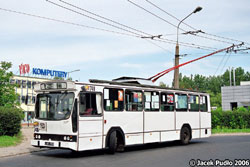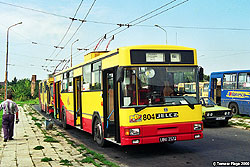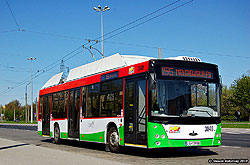After the World War II Lublin was left in poor condition. The buses used before the war were stolen or destroyed, citizens suffered from food shortage. Poland was controlled by Soviet Union and its influence was becoming more and more clear. In 1946 first city buses after war started service on urban lines. Maybe word "buses" is incorrect to describe them, because they were mainly just trucks bought from army. Repaired bus wrecks and old GMC's trucks were used to transport people to work. Public transport company tried to get some old buses and to refubrish them. This transport was of course unsufficient for a city of over 100,000 inhabitants.
Similiarly to Soviet cities, a new trolleybus system were introduced in Poland after WW 2. First one was opened in Warsaw in 1946. Second - and the last - in Lublin in 1953. Trolleybuses were believed to help very poor transport in Lublin - and they did. On 21st July 1953 first trolleybus started service on line 15, linking train station, city centre and new western district. The trolleybuses used there were 12 old JaTB-2, already worn out in Warsaw. Not surprisingly, they were much better than other vehicles used on city lines.
JaTB-2 trolleybus was the second model built in YAZ (Yaroslavsky Avtomobilny Zavod). These trolleybuses were built vefore WW II for Russian cities. Its construction of the body was partly wooden and covered by steel plates. An engine was placed between the axles and the electric equipment - behind separated driver's compartment.
JaTB-2 on first trolleybus line in 1953. Source: Zycie Lubelskie daily newspaper, 1953.
First years were full of exploitation problems, which did not discourage authorities from developing trolleybus system, maintained and ran by MPK, municipal public transport company. In 1955 a new chapter started - first Skoda 8Tr trolleybuses were brought to Lublin. As for 1950s, they were very modern - equipped with 3 doors, 11 metres long, spacy inside - unlikely to small buses from these years. Skodas provided good and reliable service on newly opened lines - to Dziesiata district, on Raclawickie avenue and on . Trolleybus depot was a small building on Garbarska street, built vefore WW II. It was used for trolleybuses as well as for buses. In years 1955-1962 a total number 44 of 8Tr was delivered.
Skoda 8Tr trolleybuses on rail cars. Source: Ekspres Wieczorny, 1956-04-07 No 084.
1960s may be described as a golden age for trolleybuses. Since 1963 new, modern Skoda 9Tr were delivered. In 1963 new bus and trolleybus depot Helenow was opened. New trolleybus lines were built - to Majdanek district, to car factory (FSC Lublin) and to newly built, modern LSM district. Skodas of good quality made the system work properly. They were much better than delivered in these years San H01 and H25 buses, which were not durable at all.
Skoda 9Tr was a Czechoslovakian trolleybus with self-supporting body made fully of steel. A series motor was placed between axles. Electric steering equipment was placed in the front wall, between driver and bumper. Special doors on the front made contactors accessible. A pack of resistors was placed on the roof. A suspension was based on leaf springs. The trolleybus had 3 doors, which helped passengers of constantly overcrowded trolleybuses to get inside and outside. In the interior seats were placed in 2+1 arrangement to leave some space for standing passengers. 55 new and used trolleybuses of type 9Tr were delivered to Lublin.
Skoda 9Tr trolleybus in front of the Krakowska Gate in the golden age of the trolleybuses in the 1960s. Source - scan of a postcard.
Situation changed suddenly in late 1960s. The government decided that there is no use in maintaining expensive trolleybuses and tramways. They believed that buses were able to replace fully all of the electric transport. Trolleybus and tramway lines were removed in cities in whole Poland. In early 1970s number of trolleybuses in Lublin started to decrease rapidly. It was planned to remove trolleybuses from Lublin until 1980s. Then, in 1973, oil crisis occured. This totally changed the plans. Because fuel might be no longer perceived as a cheap and easily attainable raw source, electric vehicles were again fashionable. In 1975 deliveries of new trolleybuses began. This time a popular Russian model - ZIU 682. In next 5 years ZIUs fully replaced all remaining Skodas.
ZIU 682 was the Russian trolleybus built in large amounts. It was equipped with series-paralell DK210A3P electric engine with continuous output power of 110 kW. Similiarly to Skoda 9Tr, electric equipment was placed in front of the driver compartment. This time it may be repaired only from the interior. The floor was at a bit lower level at the rear side of the trolleybus. ZIUs were more comfortable for the passengers because of the air suspension. It dominated the streets in Lublin - in 1970s and 1980s 138 ZIUs were delivered.
In 1970s and 1980s no major new trolleybus linies were built. Meanwhile, many new districts were built and new factories were opened. Whole new work was done by buses, which made the role of trolleybuses less important.
Brand new ZIU 682 trolleybus in 1975. Source: CAF.
In late 1980s a build of new trolleybus line to Weglin began. It proceeded very slow and finally was opened in 1990. In 1988 the fleet of trolleybuses, monopolized by ZIUs, started to change. First Polish Jelcz PR110E trolleybuses, built in KPNA in Slupsk, were delivered. In oncoming years the deliveries continued until 1992. Some used trolleybuses were bought also from Debica, where trolleybus system was shut down.
First prototype of trolleybus based on Jelcz PR110 was built in 1975, but there were too few companies using trolleybuses to made the production economically and/or politically justified, especially because huge amounts of ZIU 682 from "friendly Soviet Union" were supplied. In late 1970s only two cities with trolleybus systems survived in Poland. There were plans to open new systems, but they were delayed because of early 1980s crisis. Gdynia, dissatisfied with low quality of ZIU trolleybuses, started to built trolleybuses on its own, using new bodies from Jelcz. In 1981 four Jelcz PR110 trolleybuses with thyristor control were built in IEL Warszawa institute. One of them was tested in Lublin, but it did not stay there. Finally, in 1985 serial production of trolleybuses started in KPNA. The trolleybuses were equipped with resistor control system, which actually was completely out of date.
Jelcz PR110 was a trolleybus built in a body of Jelcz PR110U, designed in France in Berliet in cooperation with Polish engineers, basing on Berliet PR100 model. The KPNA version, with resistor control, was equipped with DK210A3P engine - the same as in ZIU - and with Polish electric equipment. All of the equipment - including contactors, additional electric engine, lightning arrester, compressor - was built in Poland, which made the trolleybus independent of foreign supplies. This fact was important in age of socialism, because there was one currency for internal trade and another for trade between other countries.
Jelcz PR110E #791 in original livery, photographed in 1997. Author: Tomasz Flaga.
The engine was placed in the rear part of the trolleybus, as well as contactors, filling the space previously occupied by bus engine. A pack of resistors was placed on the roof. Jelcz PR110E was long and big - it had 110 places for passengers. The doors were wide and body design - very modern in 1970s and still modern in underdeveloped in 1980s Poland.
Jelcz PR110E - still in use in big number in Lublin. Author: Jacek Pudlo. Date: 2006.
The trolleybuses were delivered until 1992, some with thyristor control, which was unfortunately at first not reliable. 3 articulated Ikarus 280T trolleybuses with thyristor control, assembled in KPNA in bodies of used Ikaruses, appeared in Lublin. Then, deliveries stopped. MPK tried to help the situation of the fleet with rebuilding old ZIUs and in years 1993-1994 rebuilt old, used Fiat 418AC buses into trolleybuses. Later public attention was concentrated on buses - new Jelcz's and Neoplans were delivered. People had to wait until 1998, when first new trolleybuses were built. MPK, encouraged with the success of Fiat 418AC rebuilt, decided to complete the trolleybuses in its own workshop. 3 new Jelcz 120MT trolleybuses looked modern, but in fact body of this model was upgraded Jelcz PR110.
New Jelcz 120MT photographed in 2000. Author: Tomasz Flaga.
In 1994 trolleybuses were removed from an important street in the city centre - Krakowskie Przedmiescie, where a pedestrain area was introduced. This helped the city to develope, but made the whole trolleybus system less important.
In 1999 trolleybuses were removed from Slupsk. MPK bought a batch of PR110E trolleybuses from this city. Again, used PR110E appeared in Lublin in 2001, when trolleybuses from closed in 1995 Warszawa-Piaseczno line were sold. While trolleybuses from Slupsk went straight into service, ones from Warszawa were in wreck state and needed to be rebuilt.
In 2003 and 2004 condition of trolleybuses was poor, because of insufficient investment in infrastructure and already old fleet of Jelcz PR110E trolleybuses, which were not maintained in very good condition. Trolleybuses were slow, because of old poles and obsolete overhead wires, especially on crossings and curves. An idea to remove the trolleybuses appeared, but it finally was not implemented. Due to Polish accession to European Union new possibilities appeared. Local authorities realised that it is possible to get extra funds to develope and renew trolleybuses infrastructure as well as fleet. A program of trolleybus developement was created. In 2005 and 2006 some funds were assinged and one new trolleybus line was built. Unfortunately, local authorities hesitated and big trolleybus project is being slowly realised. The plans include about 40 km of new trolleybus lines (now approx. 30 km), new trolleybus depot, located next to bus depot in eastern Lublin (currently being designed) and 70 new trolleybuses (the number has already been decreased). The project should be completed until 2015, otherwise Lublin will lost special funds.
Meanwhile, MPK tried to obtain some new trolleybuses. Almost every year new experiment was introduced. First, in 1999, a Jelcz 120MT with IGBT transistor control made by IEL was introduced. Then, in 2000 MPK started to build trolleybuses based on low entry Jelcz M121 body, using the same equipment as previously. After 2001 the financial situation of MPK got worse, which stopped any supplies of new trolleybuses until 2005, when 3 bodies of 120MT were bought and fully assembled in MPK workshop with resistor control. In 2006 MPK started to test two Polish control systems with asynchronous engine, made by Medcom and Enika. The systems were put in rebuild PR110E bodies. Then, in 2007, first Solaris Trollino 12 with Medcom control system appeared. This trolleybus was later bought by MPK and two similiar ones followed. In 2008 one Solaris Trollino 12 with Cegelec electric system was delivered, which was a part of project of new trolleybus line, supported by UE funds. This long and multithread story did not end there. To obtain possibly cheap trolleybuses, MPK started in 2009 to analise eastern trolleybus manufacturers offer. Finally, one MAZ 203T body was bought and equipped in MPK workshop with Medcom inverter and Emit asynchronous engine.
Solaris Trollino 12 and MAZ 203T - two completely different trolleybuses bought in period 2007-2010 by MPK.
In June 2010 MPK announced order for 15 trolleybuses and 15 addidional, if company gets extra UE funds. Until 2012 MPK got 30 new trolleybuses and renewed half of its fleet. In 2011 MPK had 60 trolleybuses which ran on 9 trolleybus lines. Vast majority of fleet consisted of Jelcz PR110E. The lenght of the net was 30 km.
In next years the network was expanded and new trolleybuses were bought. Until 2015 Jelcz trolleybuses were sold to other cities. In 2021 the city continues to buy new trolleybuses.










